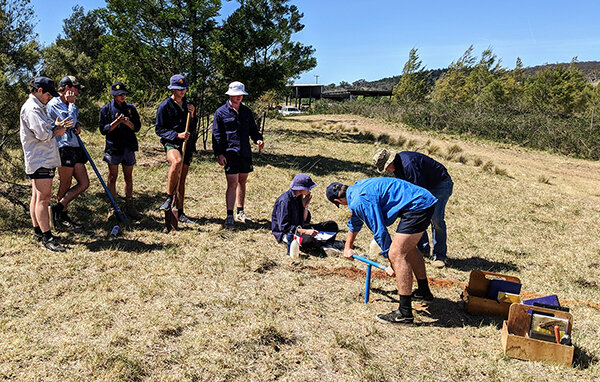Discussing floodplain soil characteristics. Note the sandy gravel soil present under the medium black clay.
Year 12 Plant Production students from The Scots College visited Mulloon Creek Natural Farms during November to learn about soils and how different soil characteristics impact plant growth, water infiltration and soil water holding capacity.
The two day visit began with a screening of Rehydrating Australia and Regenerating the Australian Landscape to give the students an overview of Tony Coote’s vision for TMI and an introduction to the issues we are working to address.
Day one commenced at the excavated soil pit, with discussions around soil characteristics and their implications for growing plants, and the water infiltration rates of different soils and their water holding capacity relative to the location in the landscape. They learnt how to conduct ‘soil characterisations’ using augers to extract soil core samples. They identified the different horizons (A1, A2, B1, etc), photographed and described the colour, texture assessment (sandy clay, medium clay etc), and tests for; pH, slaking/dispersion, soil organic carbon, calcium carbonate and root zone depth. Further discussions surrounded key elements of each group’s soil profile, how and why they were different, processes for reading the landscape, and how plants play a vital role (slowing water movement) in helping the soil harvest water (infiltration) for the benefit of plants and the soil biome.
Day two activities went on to conduct soil augers in the floodplain zone. The student groups chose test sites ranging from the edge through to the middle of the floodplain and uncovered slightly different soil profiles at each. One site had a thin layer of fine sand at approximately 75cm with a silty clay overlay, suggesting a previous minor fluvial channel. Another had a small, rounded metasedimentary pebble layer at approximately 45cm depth, suggesting this was a more pronounced fluvial stream running through the floodplain and was now part of the higher ground in the floodplain. In all, variability in the soil profile was present, however the general profile consisted of sandy/clay loam in the A horizons, with light to heavy clays in the B horizon. The pH was consistently 6-6.5 (that’s good), with test for SOC (soil organic carbon) indicating a positive in many of the A horizons (good), good root nodules and soil aggregates, with roots noted on average to a depth of 75-100cm. Notably the soil was dry in the A1 horizon, however there was some moisture in the lower horizons. Each group then presented their soil profiles to the class and explained what they had discovered.
In addition to the soil characterisation activities, students were taken on site visits that included the step diffusion site on sloping country and the creek rehabilitation works at Peter’s Pond to identify different landscape processes and how they connect and interact.
We look forward to welcoming students from The Scots College (and other interested schools) to Mulloon Creek Natural Farms in the future for similar field trips which can be tailored to suit specific curriculum and educational outcomes. Contact us via info@themullooninstitute.org to find out more.
Conducting soil sampling on a mid-slope hill site to identify the layers and their physical and chemical characteristics.

